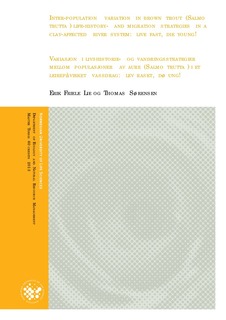Inter-population variation in brown trout (Salmo trutta) life-history- and migration strategies in a clay-affected river system: live fast, die young!
Master thesis

View/
Date
2014-02-14Metadata
Show full item recordCollections
- Master's theses (INA) [593]
Abstract
The objective of this study was to compare among-tributary variation in life-history and
migration in brown trout (Salmo trutta L.) living in the Leira river system, Nannestad
municipality. The results were to be discussed in both a general biological context as well as
potential management implications, with special emphasis on the Water Framework Directive.
Data was sampled in four tributaries and one river station over six sampling rounds during 2012
and 2013. The fish were sampled using electrofishing and fyke nets. The fish were tagged with
PIT-tags and the resulting mark-recapture data were modelled under a Cormack-Jolly-Seber
model structure. Two PIT antennas were mounted to monitor large-scale migrations within the
main river, but they did only function for a short period during the last part of the study. Scales
were retrieved for age and growth analyses.
There were population differences in summer survival, second-and third-year growth and
maturation sizes. In general, the Leira brown trout displayed a short life cycle, characterized by
rapid early-life growth, early maturation and short life-span (< 6 years). There was a general
trend with more rapid life cycles the further downstream. We suggest this gradient to be caused
by increasing environmental stress (reduced water quality and increased inter-specific
competition) downstream and possible lack of habitat. The population displaying the most rapid
life cycle (Rotua) seems to have little suitable habitat for >0+ individuals and possibly also
experience thermal stress in warm summers due to little vegetation coverage. An interesting find
pertinent to management institutions is that we found no 0+ in the main river indicating that
recruitment exclusively takes place in the tributaries. In accordance with this, we did find
evidence of fluvial-adfluvial potamodromy, but the two larger tributaries seem to predominantly
hold stationary or fluvial potamodromous individuals.
The findings are clearly in line with general life-history theory that predicts rapid early-life
growth and high adult mortality in relation to juvenile mortality to result in early maturation.
Furthermore, the unpredictable and highly variable Leira system favors early maturation and
short life cycles with high reproductive effort.
Based on our findings the brown trout population density seem to provide information sensitive
the water quality, but since there is an inter-specific competition aspect into this as well, an
eventual brown trout water quality assignment index will need to take this into account. Since
most migration interpretations in this thesis are only circumstantial a continuation of the PITantenna
monitoring program should be secured so as to complete a full-year monitoring.